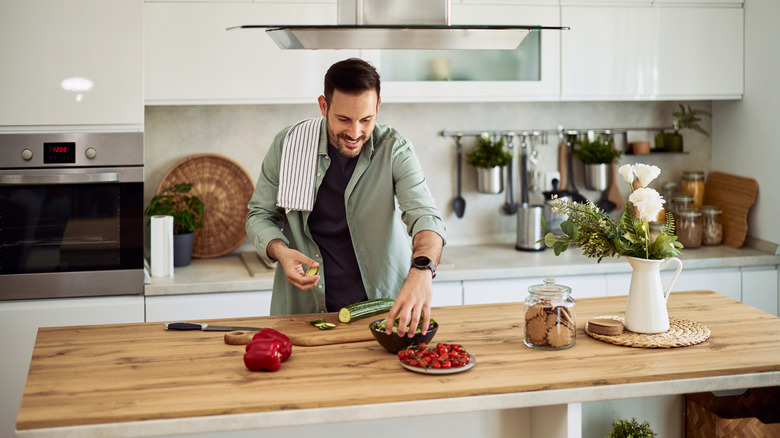Avoid Making This Classic Kitchen Island Mistake Before You Pay
Islands have been a staple of kitchen installations since the 1950s, providing functionality, storage, and a place to gather. It's no wonder they tend to act as the centerpiece of culinary home spaces, creating an easy avenue for homeowners to get carried away. But while you're fantasizing about an oversized kitchen island, it's really important to consider some negative drawbacks that might make you regret it in the future. A lot of things factor into finding the right size kitchen island, like budget and space, as well as functionality and daily needs. But, individuals don't often consider the ways that too big of an island can disrupt workflow and minimize overall living space.
When designing your kitchen, there are some important questions you should ask yourself. Like, what is the main purpose of the island for your lifestyle needs? Is it solely for food prep, additional seating, extra storage, or a combination of all of them? Knowing its intended purpose is helpful. You may already know that you should make sure the island is proportional to the size of your room and that it doesn't impede access to important areas of your kitchen or key pathways to other areas of your home. But there are other, less obvious things to consider before you start drawing up plans and pulling out your tape measure. On top of one major mistake to avoid when installing a kitchen island, another one to think about is accounting for how much space it will actually take up in the room.
A large kitchen island can disrupt workflow and overall functionality
Most people want a kitchen where they can prep and cook all their favorite meals effortlessly. This comes down to design elements that enhance ease of movement, efficiency, and organization. On the surface, a large island can feel beneficial to this goal, offering a handy prep area and additional storage to help keep things organized and easy to grab. However, you want to make sure your island complements the flow of the room without dominating it. Even in larger kitchens, it can be easy to get carried away with size, thinking bigger is better. An oversized island can also obstruct what is referred to as the primary work triangle (sink, stove, and refrigerator) — parts of the kitchen that are most used.
Disrupting the triangle disrupts how you move throughout the kitchen, usually forcing you to take extra steps every time you make your way from one spot to the next. This can increase your cooking time and make the whole process less efficient. If it's in the middle of your kitchen, you might find it awkward to easily reach for ingredients or grab tools without having to navigate around the giant island in the middle of the floor. A larger island can also be costly when you add in cabinetry, countertops, plumbing, and electricity connections, which might require tearing up the floor. Because of all of these considerations, some designers are actually beginning to wonder if kitchen islands are becoming a thing of the past.
Losing out on valuable living space with large kitchen islands
When it comes to islands, they can easily create a cramped feeling in your kitchen. Losing out on precious space for walking around, cooking, and even opening doors or cabinets can make you feel squished, especially when others are in the kitchen with you. Think of those times when you're entertaining — like throwing a dinner party or cooking a large holiday meal, where you may have several people in the kitchen at once. The space around the island should accommodate for various situations and never impede on the flow of traffic. That's why most experts recommend 36 to 48 inches of clearance on all sides, to give you enough room to maneuver around the space without bumping into anything.
Since kitchens are meant to be inviting — a place where people gather to cook, eat, and entertain — the last thing you want is furniture or fixtures that will detract from a cozy, communal feel. With a large island, you might be left with a kitchen that feels more functional than inviting, and potentially creates a visually "boxed-in" look to your space. So before you commit to an oversize island, take the time to think about the scale and layout of your room and what size island will be big enough to serve its intended purpose and fit all your needs, without disrupting the overall flow of your kitchen. You could even consider that a breakfast bar might be better than a traditional island, and go in that direction instead.


